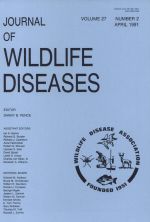Examination of 700 northern bobwhites (Colinus virginianus), 50 each February from 1971 through 1984, from Tall Timbers Research Station, Leon County, Florida, disclosed 15 species of helminth parasites. Nine species (Raillietina cesticillus, R. colinia, Aproctella stoddardi, Cheilospirura spinosa, Cyrnea colini, Dispharynx nasuta, Heterakis isolonche, Tetrameres pattersoni, and Trichostrongylus tenuis) generally were found on an annual basis and were considered characteristic components of the helminth fauna. Infrequently found species were Brachylecithum nanum, Rhabdometra odiosa, Capillaria sp., Gongylonema ingluvicola, H. gallinarum, and Oxyspirura matogrosensis. Intensities of C. colini and H. isolonche differed among host sex and age classes, and prevalences and/or intensities of A. stoddardi, C. spinosa, T. pattersoni, and T. tenuis differed between host age classes. Prevalences and/or abundances of seven species (R. cesticillus, R. colinia, C. spinosa, C. colini, H. isolonche, T. pattersoni, and T. tenuis) varied with bobwhite density, apparently because bobwhites were either the primary or only definitive host on the area. Two species (A. stoddardi and D. nasuta) did not vary with bobwhite density, apparently due to the buffering effect of a broad range of definitive hosts on the area. Prevalences and/or intensities of R. colinia, C. spinosa, and T. tenuis differed with agricultural fields status (cultivated versus fallow) suggesting that land use and its attendant habitat changes influenced transmission of these species. The occurrence of C. spinosa and T. pattersoni in individual bobwhites was not independent and was attributed to utilization of the same species of grasshoppers as intermediate hosts. Localized tissue damage and inflammation were associated with A. stoddardi, D. nasuta, C. spinosa, C. colini and T. pattersoni. Decreases in body weight in juvenile bobwhites were associated with increasing intensities of H. isolonche and T. tenuis. The observed relationships to bobwhite density and other variables are discussed with regard to known aspects of life histories of the nine most common species.
How to translate text using browser tools
1 April 1991
ECOLOGY OF HELMINTH PARASITISM IN BOBWHITES FROM NORTHERN FLORIDA
William R. Davidson,
Forest E. Kellogg,
Gary L. Doster,
Clinton T. Moore

Journal of Wildlife Diseases
Vol. 27 • No. 2
April 1991
Vol. 27 • No. 2
April 1991
Colinus virginianus
ecology
helminths
host density
northern bobwhite
parasitism
quail




